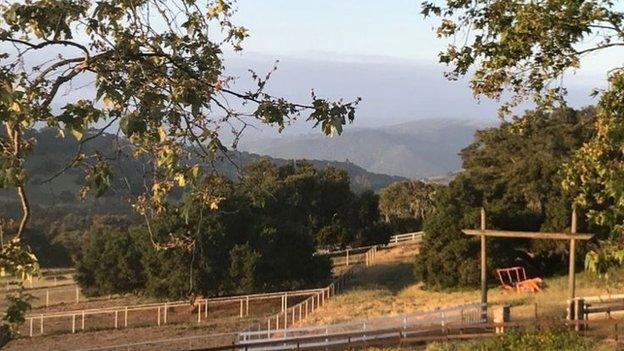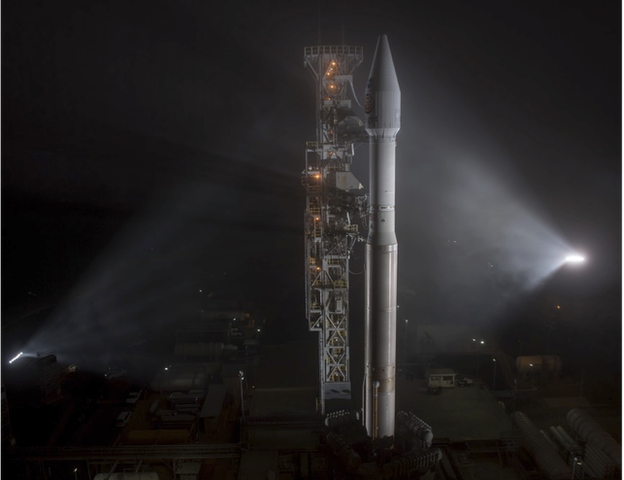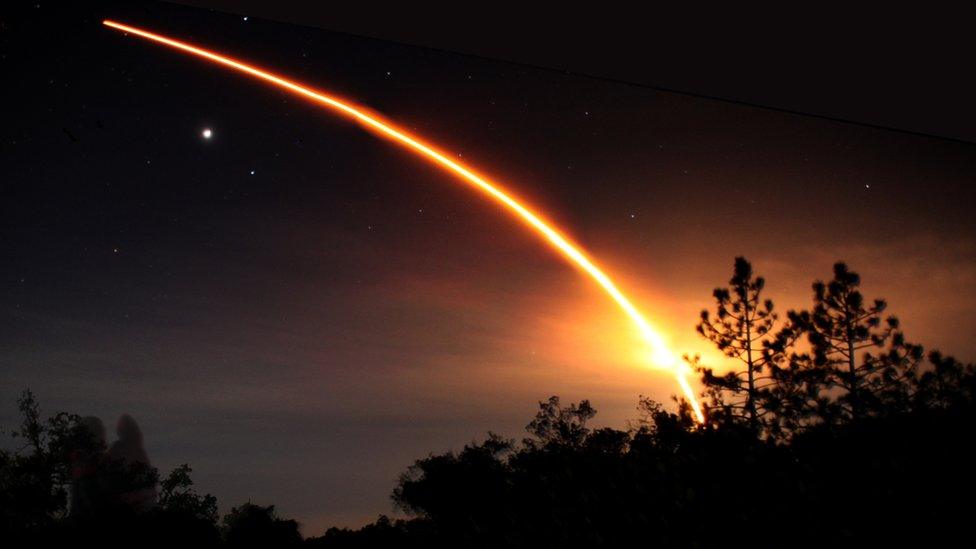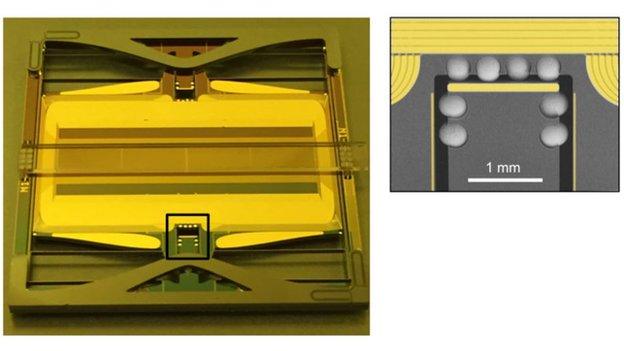InSight Diary: Mars mission emerges from the mists
- Published

The rocket launches, adding further to the "peasouper"
Prof Tom Pike from Imperial College London is part of the science team on the US-led InSight mission to Mars, external. His group has supplied seismometers, external that will enable the Nasa lander to detect "Marsquakes", which should reveal the internal structure of the Red Planet. Over the course of the coming months, Prof Pike will be updating us on InSight's progress.
This was surely the best way to see our mission leave Earth, standing in a field in California with 1,500 people from the InSight mission team.
We should be able to get a direct view of the launch pad eight miles away.
At 4 o’clock in the morning after the final go/no-go checkout was announced over the big screens, the final countdown began.
The act I had been desperate to see for the last decade was about to start. But an uninvited, and huge, member of the audience had moved right in front of all our views.
A massive bank of fog, building in the afternoon into what looked like a fresh mountain range, was rolling in from the Pacific.

The grey bank of Pacific fog that would shroud the launch site seen beyond the coastal hills of central California
From where we were staying we’d seen this thick grey mass emerging the previous evening. And now for the expectant audience in the field, we found our view of InSight at the Space Launch Complex 3 of Vandenberg Air Force Base completely blocked.
We were not going to see this launch.
As the clock ticked down, not even the launch crew were close enough to directly see the InSight rocket shrouded in thickening fog.
We only had the footage on the big screens in our field which showed the stack of thruster stages, with our spacecraft on top, lit like a Hollywood set.

The InSight rocket during final countdown with the fog moving in
As the countdown on the monitors reached zero, the rocket lifted slowly off the pad, its exhaust adding further to the murk as it cleared the tower.
In our field a thousand camera phones peered into the bank of fog in front of us, futilely trying to capture even the faintest glow from the Atlas V thrusters.
Then the rumble began as the sound rolled towards us, building to the crescendo of a giant blow-torch rising invisibly in the fog in front of us.
We might not see it, but we could certainly hear and feel the thrusters.

This spectacular image by Simon Stähler was taken on Mt Figueroa which is about 50km from Vandenburg
Phones were lowered and eyes turned away from the now useless screen footage from the rocket cams. The rest of the world was seeing our rocket leave Earth, but we were the ones feeling it.
I’d felt something rather like it before, nearly three years ago in Oxford, as we tested that our sensors would survive the vibrations of launch.
Most seismometers are too delicate to be moved, let alone launched in a rocket, unless the mass and spring mechanism that sense the vibrations of an earthquake are firmly secured to protect them from damage.
Our design is quite different. One of my Imperial College students, Dr Aifric Delahunty, had written her thesis on how to protect our delicate silicon mechanism by using tiny buffers made of solder put into etched pockets to absorb the vibration and shock of launch.

To protect the sensors, solder is melted in micro-pockets in the silicon to form buffers
We tested many sensors on the shake table at Oxford, not just at the vibration levels expected from our launch to Mars, but up to 10 times higher.
Slow-motion video of vibration testing of the microseismometer's silicon sensor at Oxford University
In our field in California while we were feeling the power of the launch eight miles away, our seismic sensors were shaking right on top the rocket. My heart jumped into my mouth as I realised just what our sensors must be experiencing at this moment.
Even after all the testing I could still scare myself.
The rumble faded as InSight continued its trajectory into a thinning atmosphere.
After the vibrations of launch, and the shock as the first-stage thruster separated, our sensors would be feeling something quite new.
InSight was now making one orbit of the Earth before turning towards Mars, and the sensors were having their first experience of weightlessness.
We had experienced InSight’s flawless launch; maybe not quite as we imagined it, but thanks to the fog more as our own sensors had felt it.
We made our way back to the buses to take us off the air force base before the Sun would try to break through the thickening fog.
Meanwhile, as they left Earth orbit with a final burn of the last thrusters, our seismic sensors had a longer trip ahead.
Tom will have another update when InSight's instruments are switched on for a check-out on the cruise to Mars.